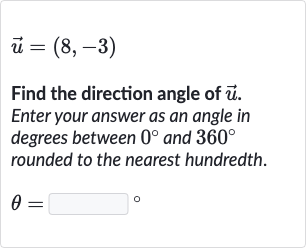Full solution
Q. Find the direction angle of . Enter your answer as an angle in degrees between and rounded to the nearest hundredth.
- Finding the Direction Angle: To find the direction angle of the vector , we need to calculate the angle that the vector makes with the positive x-axis. The direction angle can be found using the arctangent function (), which gives us the angle in radians. We can then convert this angle to degrees. The formula to find the angle is , where and are the components of the vector.
- Plugging in the Components: First, we plug the components of into the formula: . This will give us the angle in radians.
- Calculating the Angle in Radians: Using a calculator, we find that degrees. However, this angle is not between and , so we need to adjust it.
- Converting the Angle to Degrees: Since the vector is in the fourth quadrant (because is positive and is negative), we add to the angle to find the direction angle in the specified range. Therefore, the direction angle is .
- Adjusting the Angle: We round the direction angle to the nearest hundredth, which gives us .
More problems from Inverses of sin, cos, and tan: degrees
QuestionGet tutor help
QuestionGet tutor help
QuestionGet tutor help
QuestionGet tutor help
QuestionGet tutor help
QuestionGet tutor help
Question
. Find the value of in degrees.Write your answer in simplified, rationalized form. Do not round.____
Get tutor helpQuestionGet tutor help

